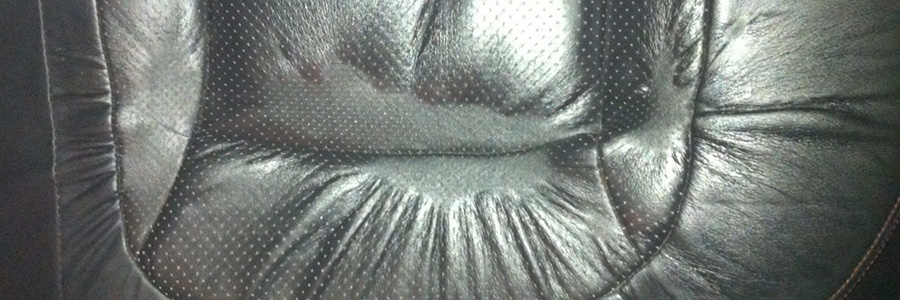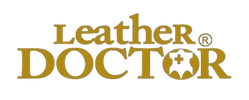Auto Leather Water and Heat Damage Restoration Kit AT5.ws by Leather Doctor is to clean, rinse, condition, and restore damages caused by water and heat.
Leather is an amphoteric material that is pH sensitive and any water with a pH value above pH3-5 will cause its fat liquor fat and oil content to be leached. Any water source that has a pH value above 3-5 will cause the protein fiber to weaken its ionic positive (+ve) attraction with the ionic negative (-ve) tanning agents and fat liquor, the hydrogen bonds weaken and the fat and oil migrate out, emptying from the source of damage and often accumulated on vertical panels with a raised ridge line. When heat is present during the accelerated drying process with insufficient fat and oil, the fibrils stick together due to the 'Van der Waal' phenomenon, and the leather stiffens out. Leather stiffness is due to the diminishing of fat that separates the fibers from sticking together stiff and oil that lubricates the fibrils like millions of interlocking hinges for smooth flexibility.
Kit AT5.ws concentrates require 1264g or 1.39 quart distilled water to be mixed and added to 1.5 inches below the top of the 8oz bottles before use.
Kit AT5.ws is composed of 3 modular systems:
Cleaning and pH Balancing Rinse with pH 1.5 and Acidifier 2.0 system,
Hydrating and Softening with Hydrator 3.3 and Fatliquor 5.0 system, and
Conditioning with Protector B Plus.
Instruction:
pH 1.5 is a pH1.5 ionic negative (-ve) charged specialty cleaner that cleans, neutralizes and pH balances leather from water damage that causes the tanning agents and fat liquor to leach out. It strengthens the hydrogen bonding between the ionic negative (-ve) constituents and the ionic positive (+ve) leather fibers.
- pH 1.5 concentrate 1: 12 is mixed with 209g distilled water or 1.5 inches from the top of the 8oz bottle before use.
- pH 1.5 is applied, brushed with horsehair brush and towel extract until the towel shows clean, and ready for acidifying rinse.
Acidifier 2.0 is a pH2.0 acidifier rinse for controlling, neutralizing, and pH-balancing leather from getting tacky.
- Acidifier 2.0 concentrate 1: 25 is to be mixed with 218g distilled water or 1.5 inches from the top of the 8oz bottle before use.
- Acidifier 2.0 is applied directly, brushed, and extracted with a towel until clean.
- Acidifier 2.0 is kept for 3 to 30 minutes to control tackiness.
- Acidifier 2.0 treatment is complete with a test for a healthy squeaky feel, ready for hydration.
- Hydrator 3.3 is a pH3.3 balanced hydrator that relaxes creases, wrinkles, shrinkage, and swelling ridges from water damage.
- Hydrator 3.3 concentrate 1: 25 requires 218g of distilled water or adding up to 1.5 inches below the top of the 8oz bottle before use.
- Hydrator 3.3 is applied following the source of the water damage passing the damaged areas to the end of the panel.
- Hydrator 3.3 working on vertical panels to restore unwanted raised ridge is dripped from the top through the stitching rows and joints by various practical applications such as a sprayer, syringe, and a paper towel as a reservoir where it seeps through the joins and stitching holes. Once the unwanted ridge is softened and relaxed, it is compressed with a roller such as a cylinder glass bottle to flatten it.
- Hydrator 3.3 works on horizontal damages such as seat stiffness and shrinkage application through the seat by wetting into the structure to soften and relax the entire panel before knuckle staking, massaging, and stretching to restoring damages to dimension, before fatliquoring.
- Hydrator 3.3 working on heat stiffness seat is simply an application over a wettable towel to serve as a reservoir, cover with plastic, and drive on it until softness is restored before fatliquoring.
- Hydrator 3.3 plays the most important role in this water-damaged restoration system and requires understanding, time, patience, and physical technique to achieve the desired result and be ready for fatliquoring.
- Fatliquor 5.0 is a pH5.0 micro-emulsion of fat, oil, and water for rejuvenating, restoring, and softening stiff water and heat-damaged leather.
- Fatliquor 5.0 concentrate 1: 5 requires 189g of distilled water or mixing up to 1.5 inches below the 8oz bottle top before ready to use.
- Fatliquor 5.0 is applied and redistributed following the same successful application technique as Hydrator 3.3.
- Fatliquor 5.0 application is repeated each cycle as water contents evaporate.
- Fatliquor 5.0 application ends when the leather absorbs no more and is left to natural drying.
- Fatliquor 5.0 sticky residue when dry is rinsed off with Hydrator 3.3.
- Fat-liquored leather is left to dry naturally for extra softness.
- Fat-liquored leather is further staked, massaged, or flexed accordingly with a little wet back with Hydrator 3.3 until dry for extra suppleness.
5: Leather Scent Protector B Plus
Protector B Plus is a classic leather scent buttery-feel, nonstick, rub-resistant conditioner that reduces wear and rubbing noises on leather. Its non-film-forming maintains the leather's essential breathability for seating comfort; helps stop the squeaking noises when leather comes into contact, reduces those tenacious dye-transfer stains, and cleans them much more easily. Its natural buttery-feel conditioning increases the leather's resistance to wet and dry rubs, thus reducing stretch, scuff, and abrasion.
- Protector B Plus concentrate 1: 15 is mixed with 212g distilled water or 1.5 inches from the top of the 8oz bottle before use.
- Protector B Plus is applied and spread by brushing or padding and is ready to use when dry.
People Also Ask:
- How to Relax Stiff Leather?
- How to Soften Leather?
- How to Relax Leather Below the Finishes?
- How to Ease Fatliquor Penetration?
- How to Move the Fatliquor to Spread out the entire Panel?
- What Can be Done with Finishes Damages?
1. How to Relax Stiff Leather?
- Stiff leather is relaxed by hydrating through the suede side and reversing the stiffness by massaging, stretching, and flexing it.
- Fatliquoring follows immediately while the leather is hydrated otherwise when water evaporates without sufficient fat and oil content it reverts stiffen.
2. How to Soften Leather?
- Fatliquor is the lifeblood of leather!
- Fatliquor fat and oil content soften, when diminished, the leather becomes stiff and when flexed leads to cracks.
- Fatliquor is replaced with ionic negative (-ve) charged micro-emulsion of sulfonated fat and oil.
- Fatliquor upon contact with the millions of ionic positive (+ve) charged leather fibrils, the water-encased fat and oil break free, hydrogen bonds take place and the water evaporates leaving a desirable transpirational breathing space.
- Fatliquor application continues each cycle as water evaporates until the last is absorbed no more.
- Fatliquored fat and oil content averaging 14% keep the leather soft and strong.
3. How to Relax Leather Below the Finishes?
- Hydration is used as a preconditioner to penetrate the leather structure, more easily from the reverse suede side, otherwise, it follows where the water has seeped in from the surface and is typically along stitching holes between panels
- Hydrator 3.3 seeping through the perforation easily moves sidewards once past the finish to hydrate the entire panel.
- Hydrator 3.3 must follow beyond the path of water damage to even out and redistribute fugitive tanning agents and fat liquor.
- Massaging, and stretching help to saturate and relax stiff leather before fatliquoring.
4. How to Ease Fatliquor Penetration?
- Perforated leather is easier to work with as there are more holes for products to penetrate, a bamboo toothpick could be used to standardize shrunk holes back to size or stitch holes on smooth leather.
5. How to Move the Fatliquor to Spread out the entire Panel?
- A practical method by hand over a plastic sheet is to reduce friction rubs to the leather finishes spreading out the fatliquor, another is sitting movement over a plastic sheet while the fatliquor is being applied.
6. What Can be Done with Finishes Damages?
- Finishing damage repairs is the second consideration after stiffness restoration success.
- Depending on the severity of shrinkage in question, where a new color refinishing is deemed inevitable a refinishing kit is required
- Embossing damages become permanent, and are not practical to recreate without pressure, heat, and an embossing plate.
- Shriveled finishes may be too delicate to work during the stretching to relax it and may result in de-lamination.
- Shriveled damaged panel finish may be shaved with Razor 60 for ease of hydrating is recommended.
Your opinions and insights are precious and will help us solve your leather problem more efficiently.
Updated January 10, 2025 by Roger Koh.
Note:
Finishes shriveled damages will require another refinishing kit:
https://leatherdoctor.com/perforated-leather-auto-seat-color-refinishing-kit-ap7-cl/








